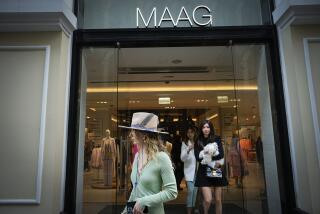Doing Business : On Going Discount in Soviet Union
- Share via
VLADIVOSTOK, Soviet Union — Russell D. Williams can claim the distinction of opening the first American discount store in the Soviet Union. All he has to do now is persuade shoppers that two months’ pay for a pair of jeans is a bargain.
Williams, from Tacoma, Wash., opened the first Ami Market last May as a joint venture in the Soviet Far Eastern city of Khabarovsk. Recently, he opened his second shop on the third floor of the GUM department store in the port city of Vladivostok.
The Ami shops feature a variety of hard-to-find American items ranging from T-shirts to parkas and from jeans to Maybelline cosmetics. In a market starved for consumer goods, he has even managed to peddle U.S.-made spaghetti at a profit.
Williams is the first American businessman to build a retail operation exclusively along the Soviet Union’s Pacific Coast. His two stores have another unusual feature for foreign retail outlets in the Soviet Union: Both take either hard currency or Soviet rubles.
The shops feature goods that Williams has managed to pick up in the United States at a steep discount, such as from store close-outs or clothes with minor defects that have been rejected by major labels. While the prices are quite reasonable in dollars when converted at the free-market rate, they are not such a bargain in Soviet currency--575 rubles for a nylon bag or 1,170 rubles for a pair of jeans. The average monthly wage in the Soviet Far East is just 600 rubles.
“At first, the Soviets were pleased to see the merchandise and shocked at the prices,” the ebullient Williams told a visitor. “Welcome to the world market.”
Despite the steep prices, Williams said the Khabarovsk shop has proven reasonably successful, allowing him to proceed with plans for expansion. In addition to the Vladivostok shop, Williams said he plans to open another store early next year on the island of Sakhalin and has purchased a share of a bigger store in Khabarovsk.
He said that although there are more tourists with dollars in Khabarovsk, there is a much larger market in Vladivostok, and its people appear to have plenty of spending money.
“The Soviets want American-style clothes. They’re quite well-versed in world fashion trends,” said Becky Marsh, the shops’ buyer, who lives in Orange, Calif.
Williams first came to the Soviet Union 2 1/2 years ago to try to sell thermal underwear to the Soviets. He figured that the Soviet Union could be the largest market in the world for his product. But the idea flopped because few people here had seen thermal underwear before.
When he asked Soviet consumers what goods they wanted in his Ami stores, they replied simply, “Everything.”
In the Soviet Far East, virtually everything in shops is rationed, down to and including wooden matches. The Ami shops have such unusual features as display racks for clothing, dressing rooms and even a return policy. Although this is ho-hum in the United States, customers in Soviet stores have to point out what clothes they want to a sales clerk and are lucky to get even a close fit.
“Nobody could believe we had the same color in a variety of sizes,” Marsh said.
The running of the Ami stores is left to Williams’ local joint-venture partner. The shops are all computerized and use bar codes for inventory control and pricing.
Williams said he prefers the Soviet Far East now, because it is close to the U.S. Pacific Coast and the tax laws are more favorable for foreign investment.
He says he has discovered a secret that other businessmen are still chasing: How to exchange the nearly worthless Soviet ruble for dollars to send back to the United States.
The Soviet currency is not convertible and, as a result, many Western businesses have steered clear of the Soviet market.
“We have a way of changing the rubles into dollars,” Williams said. “But I’m not going to tell everyone how and invite a lot of competition.”
The two Ami shops are quite small by U.S. standards, and Williams acknowledged that the only way he can begin to make serious money in the Soviet Union is by selling a large volume of clothes.
He hoped that by taking a high degree of risk now, he will be well-established by the time Japanese, South Korean and Hong Kong businesses begin their assault on the Soviet Far East market.
One feature of Soviet life has been adopted for the Ami shops: Customers have to wait in long lines to get in. In this case, however, the lines do not reflect a shortage of goods. Williams said he admits a specific number of customers at a time to maintain safety and to minimize shoplifting.
More to Read
Inside the business of entertainment
The Wide Shot brings you news, analysis and insights on everything from streaming wars to production — and what it all means for the future.
You may occasionally receive promotional content from the Los Angeles Times.










